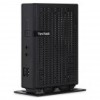ViewSonic SC-T45 SC-T45 User Guide M Region (English) - Page 14
LED Indicators, Before Getting Started - transmission
 |
View all ViewSonic SC-T45 manuals
Add to My Manuals
Save this manual to your list of manuals |
Page 14 highlights
Overview LED Indicators 1.6 LED Indicators Your SC-T45 is equipped with a Power LED to indicate the state of power. The meanings of LED signals are described as follows: LED Power LED Signal Off Blue Meaning The client is off. The client is on. The LAN port of your SC-T45 has two LED indicators showing the state of networking. The meanings of LED signals are described as follows: LED Signal Left LED (transmission rate) Off Off Orange Green Right LED (transmission activity) Off Amber blinking Amber blinking Amber blinking Meaning The client is not connected to a LAN. The client connects to a 10 Mbps LAN. The client connects to a 100 Mbps LAN. The client connects to a 1000 Mbps LAN. 1.7 Before Getting Started About FBWF (File-Based Write Filter) Before getting started on client configuration through the ViewSonic Client Setup software or through the Windows Embedded Standard operating system, please note that any changes to the system in a session will not be kept by default after the system restart. This is due to a special feature called FBWF (File-Based Write Filter) in your Windows Embedded-based system. You can change the default via the ViewSonic Client Setup software. It's strongly recommended that you read the related section in this ViewSonic Client Setup User's Manual first before making any changes to your system. WARNING • Please read the following section FIRST before making any changes to your system: "3.2.8 Configuring FBWF (File-Based Write Filter)" on page 27. About Default User Accounts There are two default user accounts for your Windows Embedded-based system: one is the standard, the other administrative. The default credentials are shown as follows: Type Administrator Standard user Account Name Administrator User Password Administrator User NOTE • The passwords are case sensitive. 6















